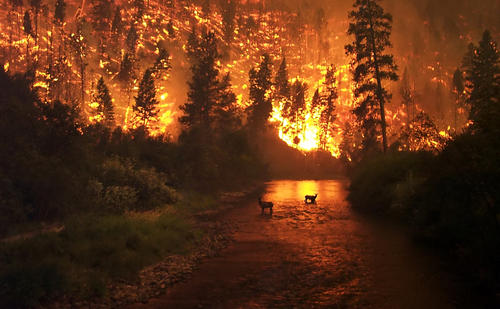Set Fire to the Range

January 12, 2021
The summer heat reaches a scorching heat across the US once a year. However, its blaze brings unbelievable damage to those who live within its vicinity . In recent years, wildfires have increased in size and occurrence. August was the peak season for fires this year in North America. So much so that the ‘August Complex,’ a wildfire that originated by lighting strikes and 38 separate fires destroyed at least 4 million acres. Within the first three weeks, the August Complex was declared a ‘Giga fire.’ That means the fire burned a minimum of one million acres of land. In California, the ‘Giga fire’ was the first Giga fire ever recorded in California, making it the most significant fire to date.
“The August complex fire was 58% contained as of early October. This year’s fire season alone accounts for five of the six biggest fires in California history. Containment will be difficult until precipitation patterns change and the drought conditions improve,” Whitney Rapp, Earth Science and Biology teacher, shares. “California gets most of its moisture in the fall and winter. Its vegetation then spends much of the summer slowly drying out because of a lack of rainfall and warmer temperatures… Each fall, strong gusts known as the Santa Ana winds bring dry air from the Great Basin area of the West into Southern California. So, there is a second fire season that runs from October through April and is driven by the Santa Ana winds. Those fires tend to spread three times faster and burn close to urban areas.”
This has a major impact on the farming industry in California. Land owners could have most of their profits [crops] in flames while others could be perfectly ripe.
“About 97 percent of the fires in coastal California are started by people, either on purpose or accidentally,” Rapp said. “This has been compounded by an extremely dry summer. With heat, plants transpire (evaporate) more water. This leaves plants dry, brittle, and the perfect material for the ignition of large fires.”
While ways to contain wildfires exist, it is hard to put them out once started fully. Mostly due to the damage of getting included in such fires. However, one of the main ways to prevent the fire from spreading to different areas is the red flame retardant spread from planes.
“Flame retardants contain thickeners to help water coalesce around particles. They also contain various ions like iron rust that slows down burning,” Chemistry teacher Dr. Theodore Jordan said. “Flame retardants are really a misnomer. They will burn, just not efficiently or right away. Flame retardant fabric will eventually burn, but it won’t catch fire easily.”
This is why the retardant is dispersed around the current fire. It will slow down the spread to help contain the fire while evacuations, rescues, and damage control proceeds. This time is critical because of current wildfire detection methods. While still effective, the current methods of manned watch towers, satellites, aircraft, and ground patrols- by foot or car. The labor required for the previous methods take up a lot of money. Not to mention the valuable time needed to send out radio warnings and TV broadcasts or door-to-door approaches that warn residents.
Luckily a new wildfire detection system is in the works. The positives of such are that it is cheap and not harmful to the environment. The self-powered triboelectric generator relays where the fire is located, how big it is, and should not be obstructed by local weather.
The downside is the quantity [of generators needed] to disburse throughout the forest. Because they are small, handheld small, a hundred of them would need to be placed in a single kilometer space.
This is not a problem in woodland areas due to the massive scale of trees provided by the west coast biosphere. However, this poses massive issues for other biosphere, such as the grasslands and mountains within the state. California contains grasslands if these generators are put there they could be tampered with by the cows, hikers, sea and land birds, not to mention earthquakes. While they would not go offline, they could send mixed signals back to the data collector for a minute or two, triggering a possible false alarm.
So what else is there to do about wildfires? There is another action in the works — it is not new. In fact, it’s been around since the 60’s. Cloud seeding is when either a land grounded generator or a plane releases silver Iodide, a chemical compound, into preexisting clouds. Cloud seeding helps speed up forming ice crystals to release precipitation to help the dry area below retain water. This would help the dry climate of California to be able to retain water helping to lower wildfires.
“Cloud seeding has been around a long time,” Jordan said. “They researched it in the 60’s, originally. And it does work. However, you have to have the right conditions to start rain to begin with. You can’t seed a cloudless sky. You can get rain to start if you provide a nucleus for water molecules to form around. This could be silver iodide or any other large atom, but silver iodide seems to work better than others.”
If provided the correct atmosphere, this could work, just not with the absence of clouds. That means it could prevent wildfires in different parts of the country will little preparation. Missouri, compared to California, has clouds almost all the time. So it could help to put out the current wildfires in the state. Which at the time of writing, Missouri has seven wildfires. This is when another issue starts, the environmental effects.
“Silver is a heavy, precious metal, so yes, it can build up in the environment because it forms insoluble compounds. It is also pretty expensive.” Mr. Jordan states.
So while it can help reduce the cost of damages from wildfires, it still adds up just as fast. This poses the question, should it be used? Yes and no, see as previously stated it can build up in the atmosphere, it cost alot and correct conditions have to be present. This means to get a consistent amount of precipitation it would need to be a rapid application of silver iodine into the air. Though California doesn’t have these perfect conditions for cloud seeding to begin with- virtually no clouds are in the sky- let alone ones that are big enough to do this on. Now you might be wondering how these fires affect Missouri? Along with the current fires in Missouri, the climate and biosphere hold perfect conditions to create more rainfall- but then we’d have too much as floods are common.





